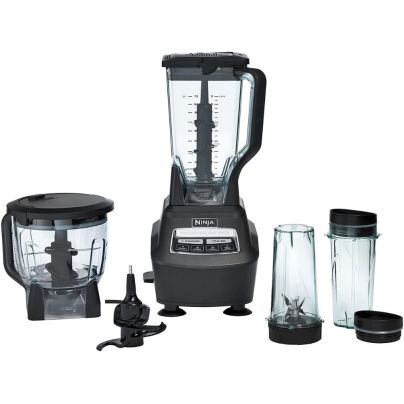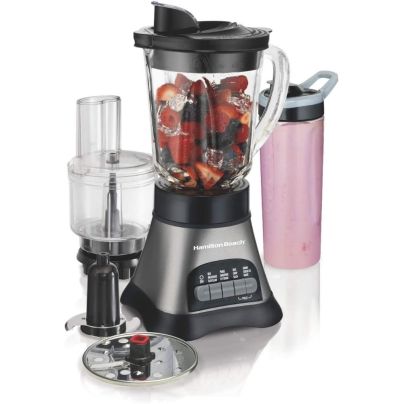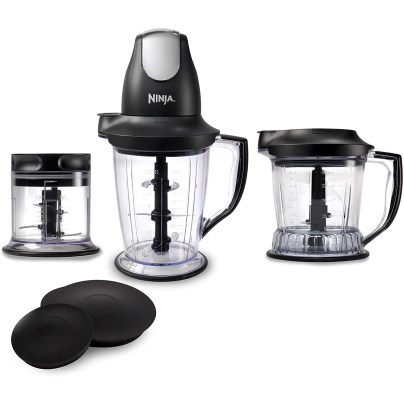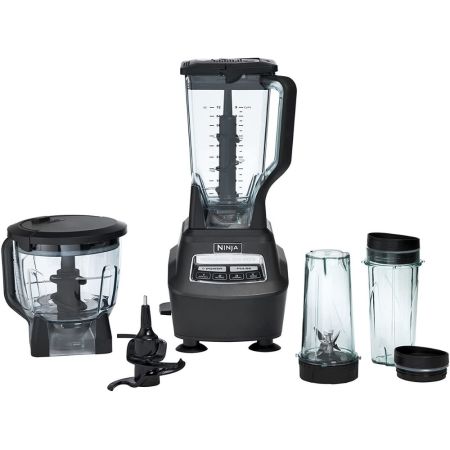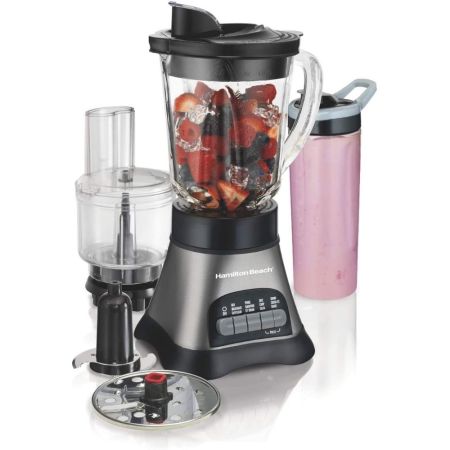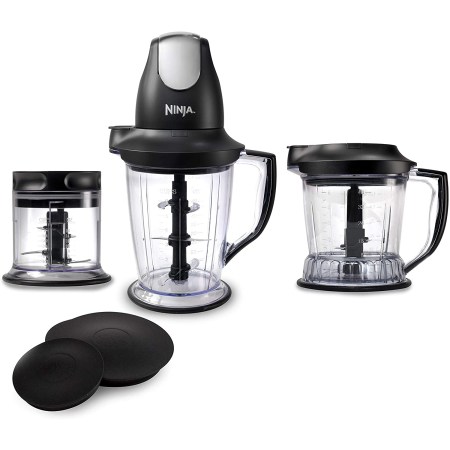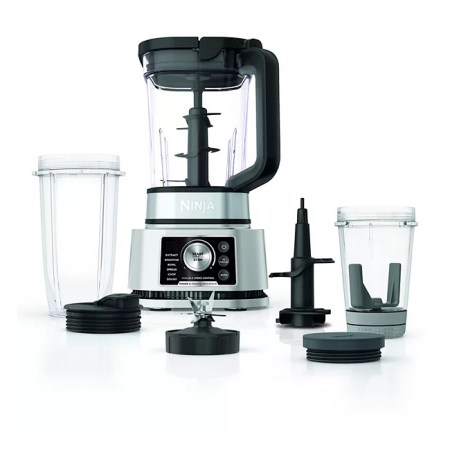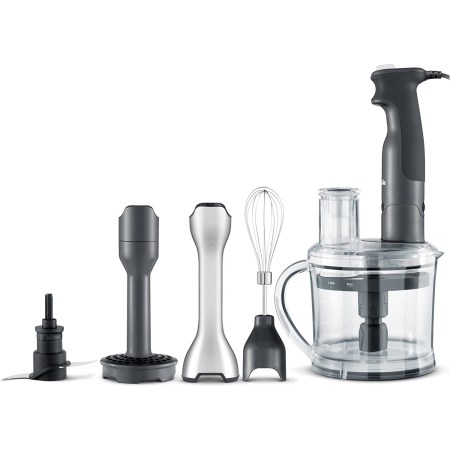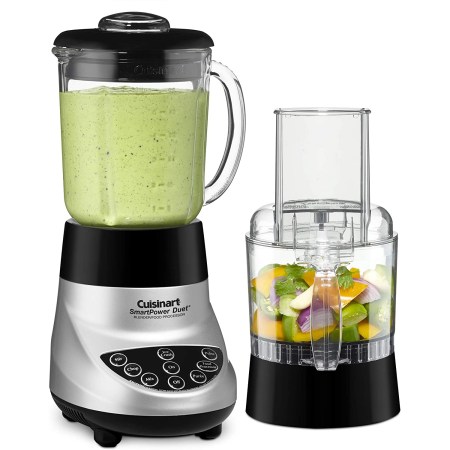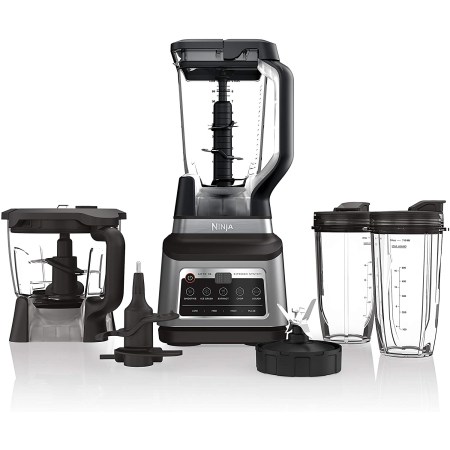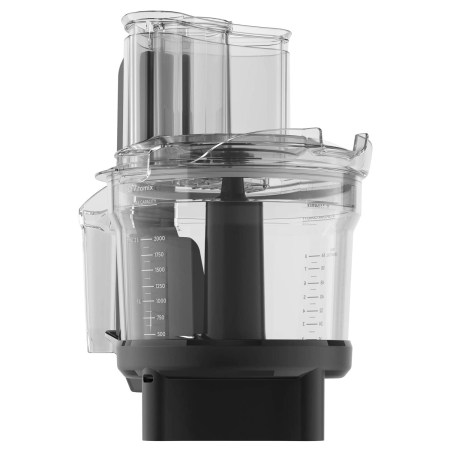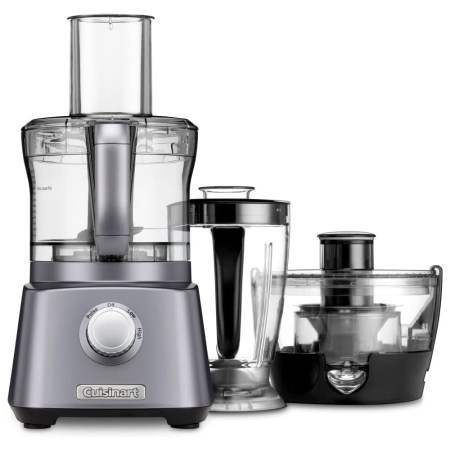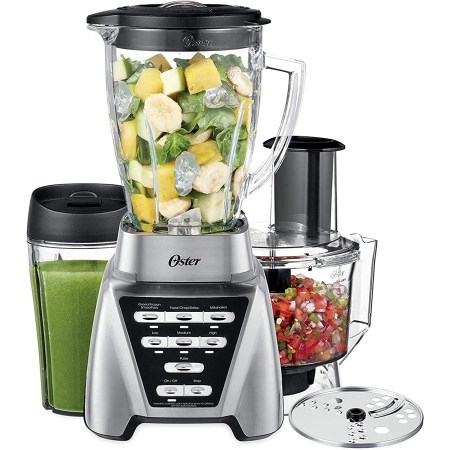We may earn revenue from the products available on this page and participate in affiliate programs. Learn More ›
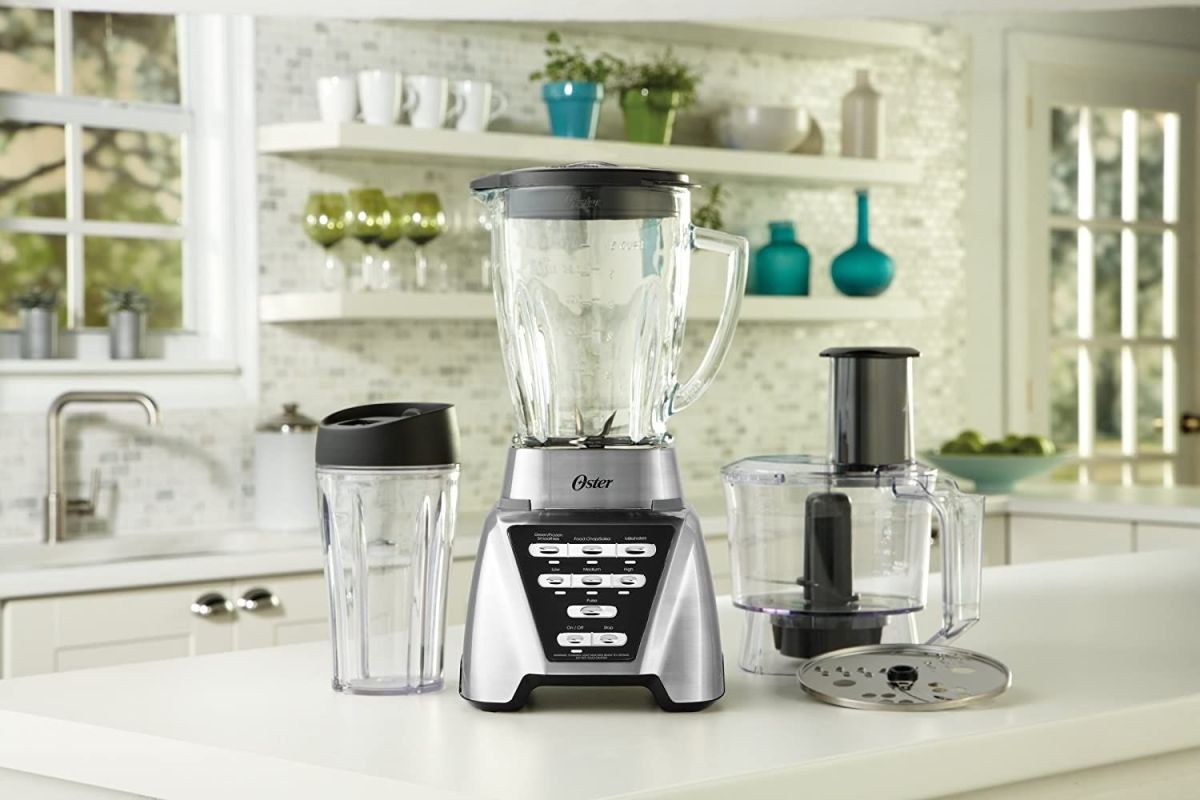
A reliable blender and dependable food processor are essential kitchen appliances, but together they can also take up quite a bit of counter space. To gain a bit more valuable storage and counter real estate, consider opting for a combination blender and food processor, a machine that can do everything from preparing smoothies to dicing vegetables to pureeing soups—and much more.
These versatile machines are equipped with a single base that matches up with separate blades, jars, and bowls for a variety of uses. Additionally, you can choose your preferred power, capacity, and settings for ingredients. In this guide we offer shopping considerations and product options to help you select the best blender and food processor combo for your needs.
- BEST OVERALL: Ninja BL770 Mega Kitchen System
- RUNNER-UP: Hamilton Beach Wave Crusher Blender
- BEST BANG FOR THE BUCK: Ninja QB1004 Blender/Food Processor
- BEST ALL-IN-ONE: Ninja SS351 Foodi Power Blender & Processor
- BEST IMMERSION: Breville BSB530XL the All in One Immersion Blender
- EASIEST TO USE: Cuisinart BFP-703BC Smart Power Duet
- BEST PROGRAMMABLE: Ninja BN801 Professional Plus Kitchen System
- BEST LARGE-CAPACITY: Vitamix 12-Cup Food Processor Attachment
- BEST WITH JUICER: Cuisinart CFP-800 Kitchen Central 3-in-1 Processor
- BEST GLASS: Oster Pro 1200 Blender and 5-Cup Food Processor
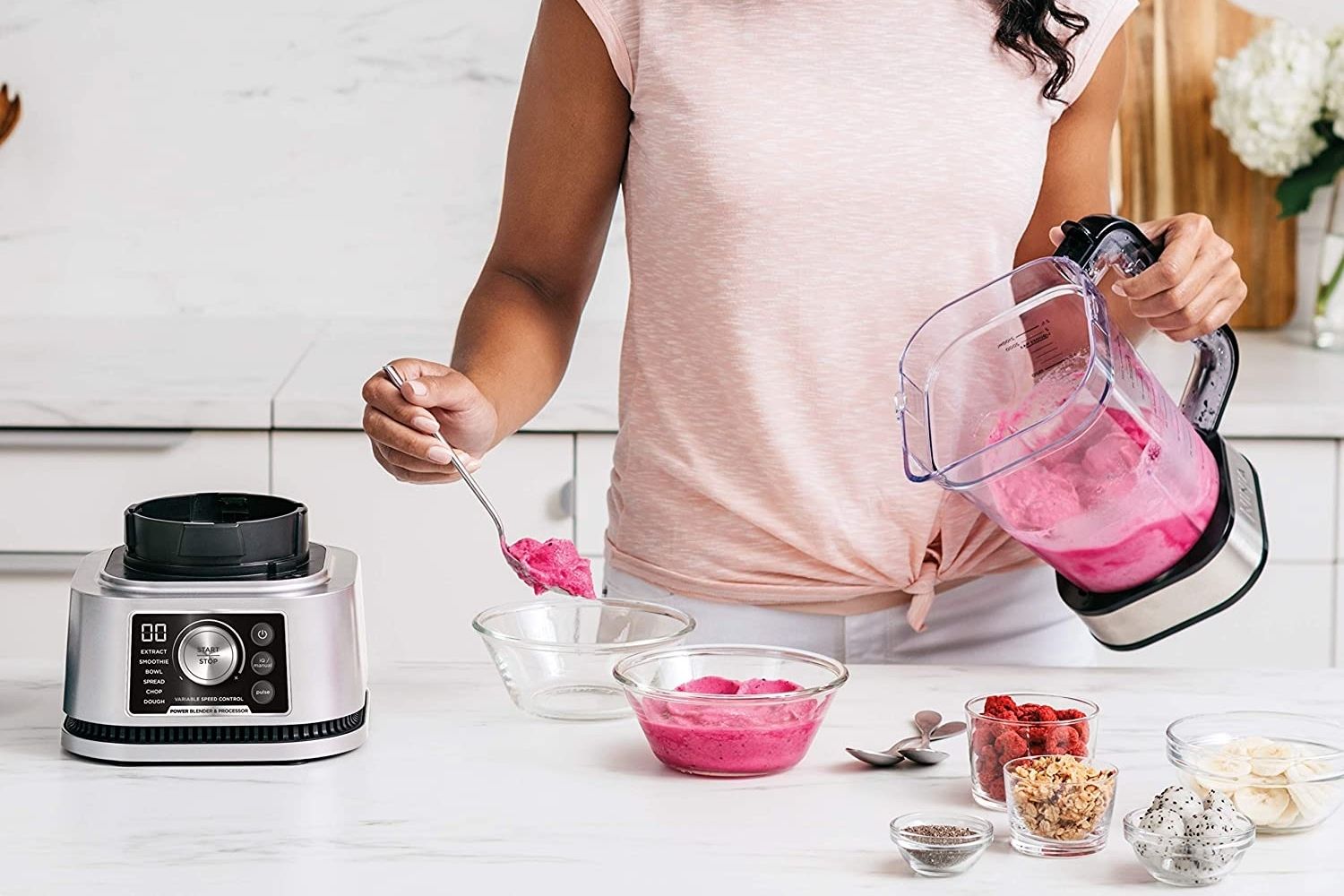
How We Chose the Best Blender-Food Processor Combos
Years of experience covering home care and appliances as well as extensive product research went into creating this guide. We explored more than 40 options for the best blender and food processor combos on the market and weighed a number of practical considerations before making our recommendations.
We chose to include options for bowls of varying capacities to provide choices for a wide variety of shoppers based on their needs and available storage space. We prioritized combo units with desirable added features like travel cups, additional blades, and other versatile accessories. All of our recommended picks earned excellent customer reviews, ensuring a positive user experience.
Our Top Picks
The best blender-food processor combo will suit specific needs and preferences, be powerful and easy to use, and include a variety of attachments for convenience and versatility. Read on to explore some of the top-rated options on the market in several categories that offer excellent overall quality and price.
Best Overall
Ninja BL770 Mega Kitchen System
See ItWith 1,500 watts of power and three blades, this Ninja blender-food processor combo is strong enough to crush ice and sharp enough to pulverize a variety of foods. Along with a chopping blade, the 8-cup food processor bowl also includes a blade that can mix up to 2 pounds of dough in 30 seconds. The 72-ounce blender features a pulse button and four speeds labeled for dough, ice crushing, blending, and single-serve processing, allowing you to choose your preferred consistency.
For taking smoothies on the go, the system comes with two 16-ounce Nutri Ninja cups and lids. With dishwasher-safe parts, the unit is easy to clean. The Ninja includes a complimentary recipe guide.
Product Specs
- Food processor capacity: 8 cups
- Blender capacity: 72 ounces
- Motor power: 1,500 watts
Pros
- Powerful 1,500-watt motor can crush ice and pulverize tough foods
- Comes with a range of blades for different tasks, including a dough blade
- Includes 2 travel cups with lids for taking smoothies to-go
Cons
- This large 72-ounce blender may take up valuable counter space
Get the Ninja BL770 blender-food processor combo at Amazon or Best Buy.
Runner-Up
Hamilton Beach Wave Crusher Blender
See ItThis combination machine from Hamilton Beach features 700 watts of power and a Wave-Action System that continuously pulls ingredients down into the blades. The unit includes a 40-ounce blender jar, a 3-cup chopper blender, and a 20-ounce personal blending cup.
The food processing bowl is equipped with an S-blade and a shredding and slicing disc. Bonus features include an easy-to-pour blender spout, a personal blender lid for transporting smoothies, and storage within the base for the cord. Dishwasher-safe parts make it easy to clean.
Product Specs
- Food processor capacity: 3 cups
- Blender capacity: 40 ounces
- Motor power: 700 watts
Pros
- The Wave-Action System continuously pulls ingredients down into the blades
- Comes with a range of containers for different tasks, including a personal blending cup
- Food processor bowl includes an S-blade and shredding and slicing disc
Cons
- The 40-ounce blender jar may be too small for larger batches
Get the Hamilton Beach blender-food processor combo at Amazon or Hamilton Beach.
Best Bang For The Buck
Ninja QB1004 Blender/Food Processor
See ItSmall but mighty, Ninja’s 450-watt blender-food processor combo can switch between 16- and 40-ounce chopper bowls or a 48-ounce blending pitcher and their respective blades. For those looking for portability or to save space, the lack of a motor base makes the unit simple to transport and easy to store.
This model features one large chrome pulsing button for simple operation, which may be a drawback for those who prefer multiple speeds and preset options. The jar and bowls are dishwasher-safe and include storage lids, no-slip bases, and splash guards.
Product Specs
- Food processor capacity: 5 cups
- Blender capacity: 48 ounces
- Motor power: 450 watts
Pros
- Lack of motor base makes it easy to transport and store
- Dishwasher-safe parts with storage lids, no-slip bases, and splash guards
- Versatile and compact with interchangeable chopper bowls and a blending pitcher
Cons
- 450-watt motor may not handle tougher foods unless cut up first
Get the Ninja QB1004 blender-food processor combo at Amazon or Kohl’s.
Best All-In-One
Ninja SS351 Foodi Power Blender u0026 Processor
See ItThe Ninja Foodi blender food processor combo boasts a 1,400-watt motor designed with SmartTORQUE technology to power through dense ingredients without becoming stuck or stalled. In addition to the multiuse jar, the system includes a 14-ounce smoothie-bowl maker equipped with a tamper to push down ingredients.
It also features a 24-ounce nutrient-extraction cup intended to preserve vitamins for healthy beverages. Six preset programs offer one-touch control for smoothies, extractions, bowls, spreads, chopping, and dough, while a variable-speed knob allows for manual control. All parts are dishwasher-safe for easy cleaning.
Product Specs
- Food processor capacity: 72 ounces
- Blender capacity: 72 ounces
- Motor power: 1,400 watts
Pros
- Powerful 1,400-watt motor with SmartTORQUE technology for efficient blending
- 6 preset programs and a variable-speed knob for customized blending
- Multiuse jar, smoothie-bowl maker, and nutrient-extraction cup for versatility
Cons
- Larger size may not be suitable for smaller kitchens or limited counter space
Get the Ninja Foodi blender food processor on Amazon or Best Buy.
Best Immersion
Breville BSB530XL the All in One Immersion Blender
See ItBreville’s the All-in-One immersion blender is a masterful kitchen companion that can take care of countless food preparation tasks. Boasting 15 speed settings, 18 slicing-thickness settings, three mashing texture options, and a double-sided shredder, this blender-food processor combo easily blends, chops, purees, and whisks ingredients to your desired consistency.
It features a 6-cup bowl for processing foods like potatoes or squash with its unique mashing/pureeing attachment. This appliance comes equipped with ergonomic design attributes, such as comfortable grip handles and trigger switches for ease of use, along with a storage base so you don’t need to worry about losing any accessories.
Product Specs
- Food processor capacity: 6 cups
- Blender capacity: 6 cups
- Motor power: 280 watts
Pros
- The adjustable speed-control and thickness settings can handle a range of food-prep tasks
- Ergonomic design with comfortable grip handle and trigger switch for easy operation
- Comes with a storage base for easy organization of attachments and accessories
Cons
- The 280-watt motor is less powerful than most other blender-food processor combo motors
Get the Breville immersion blender at Amazon, Crate & Barrel, or Breville.
Easiest To Use
Cuisinart BFP-703BC Smart Power Duet
See ItCuisinart’s Smart Power Duet blender-food processor combo provides a 500-watt motor, a 48-ounce glass blender jar, and a 3-cup food processor attachment with a chopping blade and slicing-and-shredding disc. The easy-to-use controls offer a dedicated food-processing button and options to stir, chop, mix, and puree ingredients. An ice-crushing button makes it simple to blend frozen drinks.
Adding to this model’s ease of use are features such as a removable 2-ounce measuring cap on the pouring lid and a feeding tube with a pusher for adding last-minute ingredients. Additionally, all removable parts are dishwasher-safe for easy cleanup.
Product Specs
- Food processor capacity: 3 cups
- Blender capacity: 48 ounces
- Motor power: 500 watts
Pros
- Electronic touch-pad controls are quick and intuitive; no learning curve
- Includes multiple processing blades to handle various food preparation tasks
- Glass blender jar and food processor attachment offer excellent durability
Cons
- 500-watt motor may not be powerful enough to handle tougher ingredients
Get the Cuisinart BFP-703BC blender-food processor combo at Amazon or The Home Depot.
Best Programmable
Ninja BN801 Professional Plus Kitchen System
See ItA programmable food processor-blender combo like this Ninja model features a number of presets that enable home cooks to make specific dishes or beverages with the push of a button. There are five presets—smoothie, ice crush, extract, chop, and dough—which use intelligent programming to choose the pulse, chop, and blend patterns best suited for the task at hand. There are also four manual programs: low, medium, high, and pulse.
On top of its programmability, this model has a number of other desirable features. It comes with a large 72-ounce pitcher, an 8-cup food processor bowl, and two 24-ounce single-serve cups. It uses a powerful 1,400-peak watt motor, allowing for impressive performance.
Product Specs
- Food processor capacity: 8 cups
- Blender capacity: 72 ounces
- Motor power: 1,400 peak watts
Pros
- Auto-IQ programs are ideal for quickly performing specific tasks
- Ample food processor capacity is great for preparing larger dishes
- There are single-serve cups included for user convenience
Cons
- Large size may not be suitable for smaller kitchens or limited counter space
Get the Ninja BN801 blender-food processor combo at Amazon or Best Buy.
Best Large-Capacity
Vitamix 12-Cup Food Processor Attachment
See ItOne major downside of combined blenders and food processors is that while they often come with large blending pitchers, their food-processing bowls tend to be on the smaller side. Though they’re suitable for chopping or grating small quantities of food, you might have to work in several batches to get the job done. This food processor attachment for Vitamix appliances, however, has a 12-cup capacity, which should suffice for nearly all household food processing needs.
The unit is compatible with Vitamix’s Ascent and Venturist blenders and uses Self-Detect technology, allowing it to work seamlessly with an existing device. It includes a multipurpose S-blade, a reversible slice/shred disc, and two food pushers.
Product Specs
- Food processor capacity: 12 cups
- Blender capacity: N/A
- Motor power: Dependent on blender model
Pros
- Ample 12-cup capacity is large enough for most households
- The attachment is compatible with existing Vitamix blenders to extend versatility
- There are multiple blades included to handle a wide range of food preparation tasks
Cons
- Requires owning a Vitamix blender
Get the Vitamix food processor attachment at Amazon or The Home Depot.
Best With Juicer
Cuisinart CFP-800 Kitchen Central 3-in-1 Processor
See ItThe Cuisinart CFP-800 Kitchen Central blender, food processor, and juicer combo is a versatile kitchen appliance. This powerful machine features a 500-watt motor that can chop, blend, puree, shred, and juice fruits and vegetables, making it a great addition to any home kitchen.
Equipped with a large-capacity 8-cup food processor bowl and a 40-ounce blender jar, this combo model can handle all types of food preparation tasks, from chopping vegetables for salsa to blending smoothies and pureeing soups. The juicer attachment allows the creation of fresh, healthy juice in seconds, and the included slicing and shredding discs provide even more versatility.
Product Specs
- Food processor capacity: 8 cups
- Blender capacity: 40 ounces
- Motor power: 500 watts
Pros
- Triple-threat appliance can function as a blender, food processor, and juicer, offering optimal versatility
- The well-designed control dial offers top-notch ease of use
- It comes with dishwasher-safe parts, making cleanup a breeze
Cons
- The 40-ounce blender jar may not be large enough for some users’ needs
Get the Cuisinart CFP-800 blender-food processor combo at Amazon or The Home Depot.
Best Glass
Oster Pro 1200 Blender and 5-Cup Food Processor
See ItThe Oster Pro 1200 blender-food processor combo is a versatile kitchen appliance that offers powerful performance and convenient features. With a 1,200-watt motor, this appliance can easily blend, chop, and puree a variety of foods from smoothies to sauces to soups.
It comes with a 6-cup glass blender jar, a 5-cup food processor bowl, and a stainless steel slicing disc and chopping blade, which lets home chefs prepare a wide range of recipes. A 24-ounce smoothie cup lets you quickly blend a drink and then take it on the go to work, school, or the gym.
One of the standout features is Smart Settings technology, which offers seven speeds and three preprogrammed settings for optimal performance. Whether blending frozen fruits or pureeing hot soups, Smart Settings ensures that the device adjusts to the perfect speed and power level for the task at hand.
Product Specs
- Food processor capacity: 5 cups
- Blender capacity: 6 cups
- Motor power: 1,200 watts
Pros
- Powerful 1,200-watt motor can easily blend, chop, and puree a variety of foods
- Smart Settings technology offers 7 speeds and 3 preprogrammed settings
- Includes a 24-ounce smoothie cup for on-the-go drinks
Cons
- May be loud during operation due to powerful motor
Get the Oster blender-food processor combo at Amazon or Target.
Jump to Our Top Picks
What to Consider When Choosing a Blender-Food Processor Combo
The best blender/food processors perform well at both intended tasks. Before making a purchase, consider several factors, including the unit’s size and capacity, motor power, lid and feeding-tube options, blades, and attachments. For ease-of-use concerns, it’s also important to take note of the available controls and settings.
Food Processor vs. Blender
Food processors and blenders are similar food preparation devices, yet while these small appliances share some traits, they also differ in several ways. Blenders are designed to combine and homogenize wet and dry ingredients, and they typically require liquid. Food processors can perform a variety of tasks, from dicing vegetables to shredding cheese to kneading bread dough.
Both appliances feature sharp blades that break down and process food, but they rely on different bowl shapes to suit their tasks. Food processors use wide, shallow bowls, while blenders use taller pitchers.
Size and Bowl Capacity
A blender-food processor combo includes both a jar for blending and a bowl for mixing. Combination machines can vary significantly in capacity, with blender jars typically holding 3 to 14 cups and food processor bowls holding about 3 to 8 cups. If smoothies on the go sound enticing, there are plenty of options that include a cup-size personal blender attachment that you can remove and take on the road.
When deciding on the size of a blender-food processor combo, consider any cooking and entertaining needs as well as the available kitchen storage space. Larger options may be optimal for those who entertain often, but those who are short on countertop or storage space may want to choose a smaller unit, or even a portable one. More compact versions can still be quite versatile with the inclusion of a chopping cup that acts as a mini food processor.
Motor Power
The power of a combination machine is measured in watts, with higher food processor wattage equating to speedier, more efficient operation. Most blending and chopping devices range anywhere from 350 to 1,500 watts, with blenders usually requiring more horsepower for liquefying. Machines with higher wattage often have a higher capacity than lower-wattage choices.
When choosing the best food processor-blender combo, aim for at least 700 watts of power. If crushing ice is a goal, look for options with more than 1,000 watts of power, which is also the ideal blender wattage for smoothies. Some machines with higher wattage include a cooling feature that automatically turns off the blender if it begins to overheat.
Blades
The blades are arguably the most important part of any blending or chopping machine. In general, sturdy stainless steel options are optimal, but the shape also matters. That’s why combination machines often include two or three sets of blades to use with the same base.
Food processor attachments will typically feature both an X-shaped and an S-shaped blade. For standard blending, an X-shaped blade is generally the most efficient. An S-shaped blade is best for chopping and mixing when used on the pulse setting, though it can efficiently blend and puree as well. A third blade for kneading dough may be included as well as disc attachments for slicing and grating when food processing.
Controls
The best blender-food processor combo will be clearly marked and easy to use with touch buttons or knob controls. Most basic devices include an on-off button, a few variable-speed choices, and a pulse option, which is a necessity for food processing. For cooks who want a bit more instruction, some models feature control labels based on the function that they provide, such as blend, crush, and chop. Look for backlit or LED-indicator controls as an added bonus.
Settings
Some users like to have manual control over their blending or processing, but for those who want to remove the guesswork, consider units with preprogrammed settings. These options will feature button presets with the time and speed to make specific items, such as milkshakes, frozen drinks, and salsa. Combination machines may include a food processing or smoothie setting to pair with their respective attachments.
Additionally, some machines feature a power setting that automatically reverses the blades to release jammed ingredients. Other useful functions might include overheating protection and a self-cleaning setting.
Lid and Feeding Tube
A feeding tube is the part of the food processor that acts as a food chute for adding ingredients. To eliminate the need to cut items before processing, choose one with the option to handle various food shapes and sizes. Using a shredding or slicing disc along with the feeding tube yields finer cuts of food. A plunger safely pushes ingredients down to the blades.
The lid should fit snugly without being difficult to open or close. It often includes a rubber gasket to prevent leaks. Combination machines with safety lids prevent them from operating unless properly sealed.
Attachments
A blender-food processor combo often comes with a variety of attachments, the most basic being a blender jar, a food processing bowl, and its respective blades. The best food processor for dough will also include dedicated dough blades.
Some models include different-size blending attachments, such as a single smoothie to-go container or a small chopping cup. The food processing attachments may also provide different discs specifically for functions such as slicing, grating, and peeling ingredients. For those who would like to make fresh juice and save space on a separate machine, citrus and noncitrus juicing attachments are often sold separately.
FAQs
Now that you’ve learned about what to look for while shopping for a blender-food processor combo, there may still be some lingering questions about specifics. Read on for answers to some of the most frequently asked questions about these versatile combination machines.
Q. Can I make smoothies in a blender-food processor combo?
Yes, you can definitely make smoothies in a blender-food processor combo. In fact, many blender-food processor combos come with a separate cup specifically designed for blending smoothies. These cups are usually smaller than the standard blender jar, which makes them perfect for single servings. They typically also come with lids, which makes them convenient for on-the-go use.
For those that don’t, the blender jar attachment can easily accommodate smoothie ingredients. You may also want to try the processor for grinding flax and other seeds to add to your favorite smoothie recipes.
Q. How do I clean my blender-food processor combo?
Cleaning a blender-food processor combo is an important part of maintaining its performance and extending its lifespan. Fortunately, many blender-food processor combos are designed with easy cleaning in mind. Occasionally, a unit will provide a self-cleaning setting that only requires adding soap and pressing a button.
The best blender-food processor combos can be disassembled and run through the dishwasher, which makes cleaning up a breeze. Simply remove the blades, jars, cups, and other attachments and place them in the dishwasher. However, it’s important to check the manufacturer’s instructions to ensure that all parts are dishwasher-safe. However, the motor base should always be wiped down with a damp cloth and not submerged in water.
Q. How long will my blender-food processor combo last?
The lifespan of a blender-food processor combo can vary widely depending on several factors, including the make and model, frequency of use, and how well it is maintained. Some units can endure many years of use if taken care of properly, while others may wear out much more quickly.
One of the most important factors in determining the lifespan of a blender-food processor combo is the quality of its materials. The longest-lasting units are typically made of durable materials such as stainless steel and thick glass, which are less likely to crack or break over time.
Q. Can you use a blender as a food processor?
While it’s technically possible to use a blender as a food processor, you likely won’t get the results you’re looking for. This is because blenders and food processors are designed to perform different tasks in the kitchen. Blenders are typically used for mixing and pureeing liquids, while food processors are designed to chop and shred solid foods.
When using a blender for food processing tasks, the results can often be overly smooth or even liquified, which may not be ideal for certain recipes. For example, if you are trying to chop onions in a blender, you may end up with a puree rather than the diced onions you need.
Why Trust Bob Vila
Bob Vila has been America’s Handyman since 1979. As the host of beloved and groundbreaking TV series including “This Old House” and “Bob Vila’s Home Again,” he popularized and became synonymous with “do-it-yourself” home improvement.
Over the course of his decades-long career, Bob Vila has helped millions of people build, renovate, repair, and live better each day—a tradition that continues today with expert yet accessible home advice. The Bob Vila team distills need-to-know information into project tutorials, maintenance guides, tool 101s, and more. These home and garden experts then thoroughly research, vet, and recommend products that support homeowners, renters, DIYers, and professionals in their to-do lists.
